Hildre-Reiten History¶
Internal Links¶
Links are provided of the following types:
ADDITIONAL INFORMATION and BLUE LINKS WITHIN TEXT: These links are provided to alert the reader to supplemental information or stories pertinent to the present discussion.
PHOTO: These links connect you to pictures or photos of significance to the discussion.
SOURCE: These references are provided to credit the sources of the information provided in the text which follows, the text may not include the entirety of the original source discussion.
In each case clicking on the link will connect you to the information.
Selecting the upper left return arrow will return you to previous pages.

Preface¶
Read the following sections of Hildre-Reiten History for background information including a very concise summary of recent Nowegian history and the common history of the Reiten and Hildre families in the area of More og Romsdal, Norway. This section is identical to the first section of the Reiten Family History, so if you have previous read it there, you may prefer to jump ahead to more specific information beginning in the section labeled Hildre History.
Note: Sections listed with all capital letters in the Table of Contents are from The Reiten Family Book by Sister Paula Reiten, OSB 1984.
Norwegian History¶
Introduction
What is known today as Norway (or Norge to its own inhabitants) began as Norvegr, meaning 'the way north'. Following the gradual unification of the country from various petty kingdoms it came to be called 'Noregr'. During the Middle Ages this gradually became 'Noreg' before ending up with the current 'Norge'. Another, rarer name during the Viking period was 'Norrmannaland', land of the northmen, but this was used mainly by foreigners.
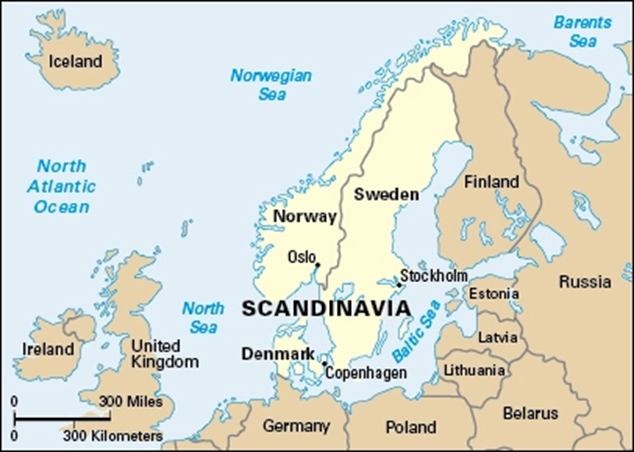
The Hildre and Reiten families originated from what is now called the "county" of Møre og Romsdal identified in the map below including the cities of Molde and Alesund. The area that became known as Hildre is located on the coast near Alesund..
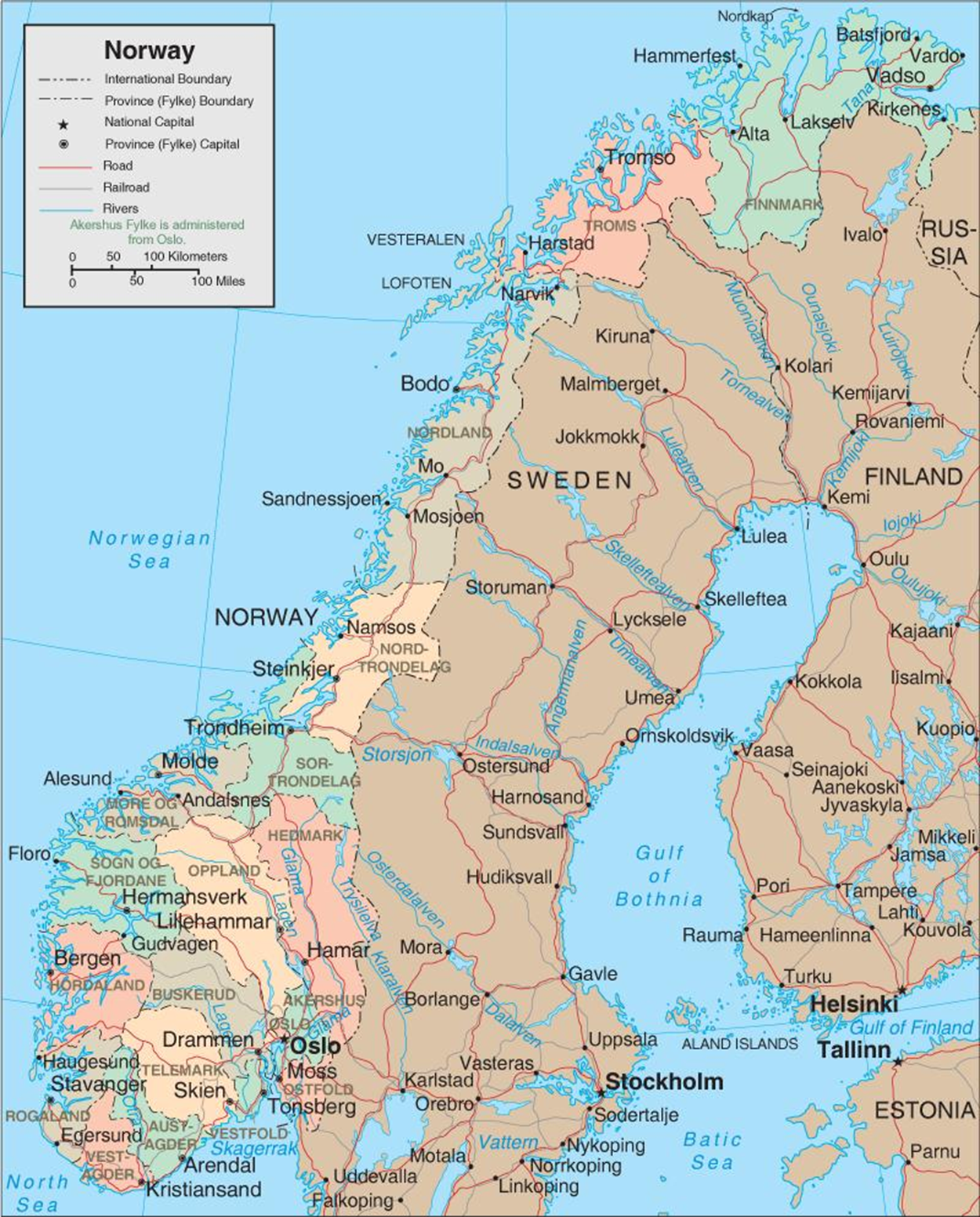
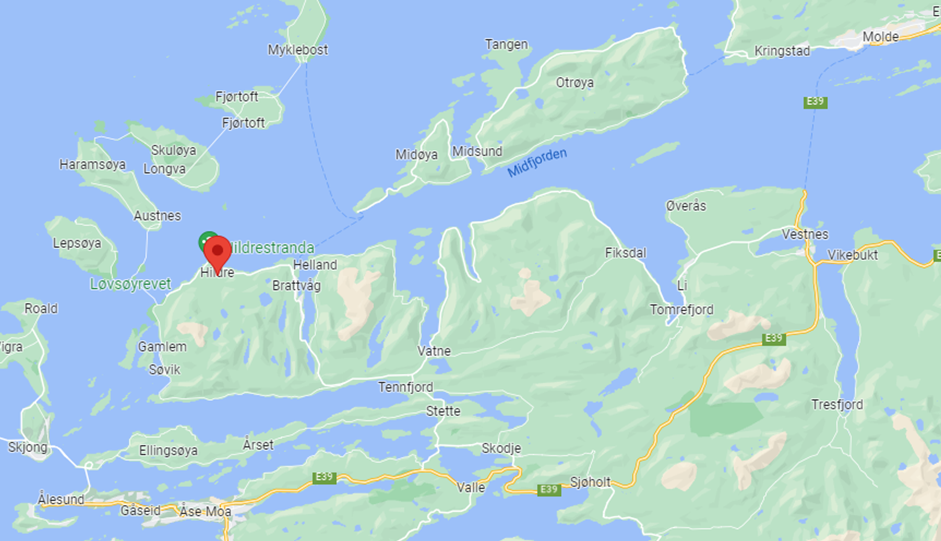
Hildre location relative to Alesund (lower left) and Molde (upper right)
Following is a very concise timeline of the history of Norway with a few sections dealing more specifically with Møre og Romsdal (in italics).
500 BC – 750: Iron Age in Norway
During the centuries prior to 100 AD the Hallstatt culture of Northern Europe expanded its influence as well as Germanic languages into southern Scandinavia.
100 AD - 450 AD: The period of Roman Empire expansion enabled significant trade and cultural exchange between Scandinavians and northern Germanic tribes. Trade including coins, vessels, glass objects, buckles and weapons as well as luxury goods like gold and silver began to increase. The period became known as the Roman Iron Age.
550 AD - 750 AD: Some powerful farmers at that time became regional chieftains and their power increased as other Germanic tribes migrated northwards and local farmers wanted protection the chieftains could provide.
750 AD – 1100 AD: The Viking Age in Norway
An era of exploration and expansion. In addition to being warriors, these Norsemen created social institutions, oversaw the conversion to Christianity and left a big impact on European history.
793 AD: The beginning of the Viking Age is often regarded as the raid on Lindisfarne in the British Isles.
872 AD: Icelandic historians believe Harald Fairhair became the first King of Norway. He is said to have unified Norway.
Møre og Romsdal The identity and history of the early kings of Møre and Raumsdal originate from Norse sagas and have little representation in historical documents.
Møre and Raumsdal Legends
According to legend, the land of Raumsdal is named after Raum the Old, son of king Nor, legendary founder of Norway.
Raum the Old married Bergdis (a giant’s daughter)
Child of Raum the Old: Jøtunbjørn ('Giant-bear') the Old Raumsdal
Child of Jøtunbjørn ('Giant-bear') the Old Raumsdal: King Raum
Child of King Raum: Hrossbjörn
Child of Hrossbjörn: Orm Broken-shell
Child of Orm Broken-shell: Knatti
Children of Knatti: Thórolf and Ketill Raum
Based on legend, some of Thórolf’s descendents were among the first settlers in Iceland and the son of Ketill Raum who was called Ketill Flatnose was a prominent Viking chieftain (circa 850) credited with conquering the Hebrides and the Isle of Man. The Norwegian king, Harald Fairhair, appointed him the ruler of these islands, but when Ketill failed to pay tribute to the king he was outlawed. Ketill Flatnose and his family left Norway for Scotland, then Ireland, where his daughter, Aud the Deep-Minded married Olaf the White, king of Dublin. Aud would later move to Iceland where she began that country's shift to Christianity.
In the early nineth century King Eystein "Glumra (the Noisy)" Ivarsson ruled neighboring Oppland.
Child of King Eystein "Glumra (the Noisy)" Ivarsson: Ragnvald Eysteinsson (830–890) (Norwegian: Ragnvald Mørejarl), became jarl (earl) of Møre and close associate of King Harald Fairhair
Ragnvald Eysteinsson (830–890) married Ragnhild Rolfsdaughter.
Children of Ragnvald Eysteinsson: Hrolf Ganger and Tore Teiande. Tore Teiande became Earl of Raumsdal after his father’s death. Some historians believe that Hrolf Ganger was the famous Viking known as Rollo, who became ruler of Normandy and was the direct ancestor of William the Conqueror.
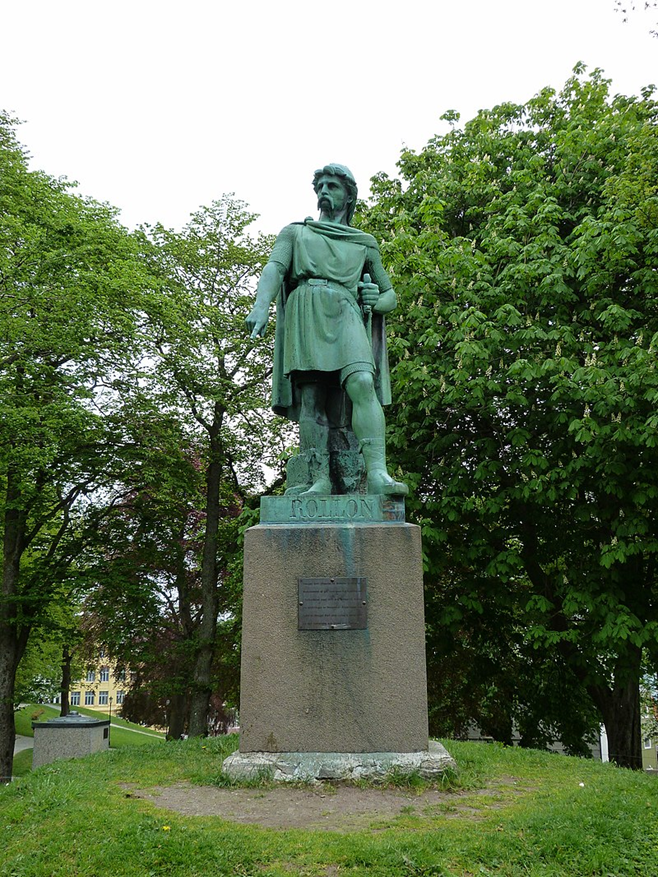
A statue of Rollo in Ålesund, Norway By Delusion23 - Own work, CC BY-SA 4.0, SOURCE
900 AD: Battles continue in Britain over land and power, while Vikings sail into France and along the Mediterranean.
981 AD: Expelled from Norway and Iceland, Erik the Red settled in Greenland with 25 ships, people and goods. More than 3,000 Vikings were said to be living on Greenland as farmers at one point. Vikings also discovered Newfoundland after being blown off course on a voyage to Greenland.
995 AD: The founder of Trondheim, Olav Tryggvason built the first Christian church in Norway.
1030 AD: Norway's Christian King Olav Haraldsson was defeated in the Battle of Stiklestad. Churches and shrines to Saint Olav were built in his honor across Europe. However, some historians doubt the authenticity of the battle.
1100 - 1400 AD: Late Middle Ages
Many chieftains feared that Christianity would rob them of power, so it took centuries for the new faith to be fully accepted. For many years people practiced a blend of pagan and Christian rituals and beliefs.
1100 AD: Population increased drastically. Many farms were divided into smaller plots of land, with some landowners turning over their land to the King or church during tough times.
1130 AD: After almost a century of peace, ambiguous rules of succession led to a civil war.
1280 AD: Known as Norway's original ‘golden age', the late 13th and early 14th century was a peaceful time of increasing international relations.
1349 AD: Many communities were entirely wiped out as the Black Death arrived in Norway. The disease killed a third of the population within a year. The subsequent drop in tax income weakened the King so the church became more powerful.
1360 AD: The Hanseatic League took control of a lot of international trade via its establishment in Bergen.
1400–1800 AD: The Scandinavian Unions
The Kalmar Union was a personal union between Norway, Denmark and Sweden – which at the time also included much of modern Finland – under a single crown.
Møre og Romsdal: The towns of Åndalsnes, and Molde (red boxes below) became major trading centers around 1600, replacing Veøy (solid red marker) as the principal market town for the region. The red circle indicates the location of Hildre, Norway.
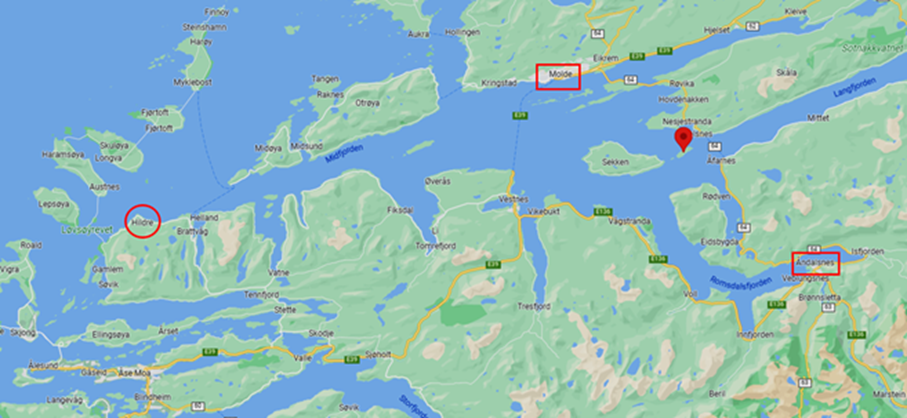
In the 1658 Treaty of Roskilde the Trondheim region of Norway was ceded to Sweden, down to the north bank of the Romsdalfjord. The Romsdal farmers defied the Swedish taxes and military conscription, and the Swedish governor was forced to send a full company of soldiers, and 50 cavalry besides, to collect taxes. Following the attack on Copenhagen and the city's successful defence, and the reconquest by Norwegian forces of Trondheim, the Treaty of Copenhagen in 1660 restored that province to Norway. The few months of experience with Swedish taxation and conscription left such a bitter taste that it strengthened Norwegian unity and patriotism, making resistance to Swedish invasions of Norway stronger over the next 80 years.*
1524–1814 AD. The Kalmar Union dissolved, but Norway remained in a personal union with Denmark. While the crowns were united, the two countries retained their own laws, currencies, and militaries. Norway was part of the Kingdom of Denmark-Norway. Following the defeat of Napoleon's troops at the Battle of Leipzig in October 1813, the Treaty of Kiel of January 1814 ceded Norway to Sweden.
1814 - 1905 AD: Norwegian Independence
1814 AD. There was a movement initiated to establish an independent nation which resulted in the signing of the Norwegian constitution at Eidsvoll.
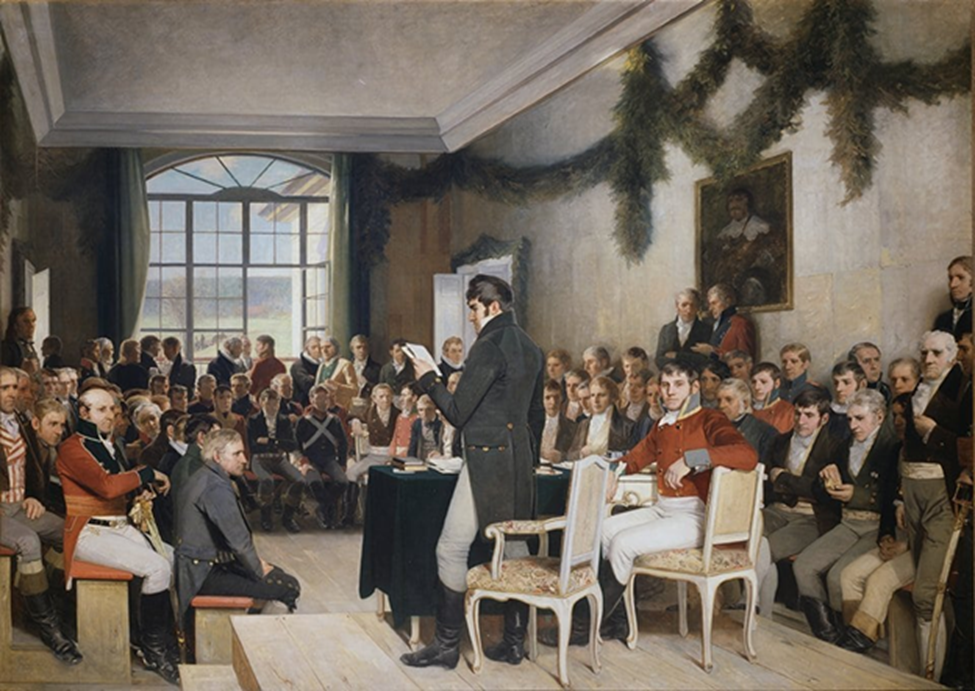
The 1814 constitution assembly. Painting by Oscar Wergeland. | Photo: Teigens Fotoatelier A/S - Stortinget cc pdm.
1814–1905 AD. Nationalistic aspirations were soon frustrated by Swedish victory over Norway in a brief war. To avoid further bloodshed, Norway entered into a personal union with Sweden, and the constitution was amended to form the Union between Sweden and Norway. While Norway was to keep most of its own institutions, the two countries were to share a common monarch and a common foreign policy.
Throughout the century improved hygiene and significant medical progress resulted in a drastic fall in child mortality and rapid increases in population. Many people moved to the cities and became part of a growing industrialization. From the mid-1800s onward, somewhere between 750,000 and 1 million Norwegians emigrated, primarily to North America.
During this period the building of roads and railroads improved communication and the movement of goods. The Norwegian communities were revitalized, and there was a political and cultural awakening.
1905 AD. Negotiations between the two governments eventually led to full independence. Sweden recognized Norway as an independent constitutional monarchy.
ADDITIONAL INFORMATION: Early Møre og Romsdal History
ADDITIONAL INFORMATION: Video: Norse Mythology Explained In 15 Minutes
ADDITIONAL INFORMATION: Videos: Scandinavian Folklore
The remainder of this Hildre - Reiten History and the text in the links for the Hildre Family and Reiten Family are taken from The Reiten Family Book researched and written by Sister Paula Reiten (1984). Genealogy listings in the text for both families was supplied, in part, from the Reiten Book (Outline sections in all capital letters) along with additional research.
INTRODUCTION TO HILDRE-REITEN HISTORY¶
The Reiten and Hildre families had lived in Norway for generations. When members of both families emigrated from Norway to the United States in the latter part of the nineteenth century, they were pulling up deep roots from one land and culture and transplanting them in another land and culture half a world away. This was no small undertaking and required strength and courage and vision. Following is a brief look at Norway and its emigration patterns, at what life was like in the new world in the 1880s, and a bit about the Reiten and the Hildre family roots in Norway.
NORWAY¶
Norway, the northwestern part of the Scandinavian peninsula, and the northernmost country in western Europe, is a long narrow coast country fringed by countless rocky islands. It faces west looking toward Greenland and the North American continent.
Though Norway covers an area of 125,180 square miles, not quite as much as North Dakota and Iowa combined, only about 10% of the land is habitable. About 3% of the land is arable; most of that, which is given over to small farms, is rocky soil. About 20% of the country is forestland, 4% is covered by lakes, and 75% is mountainous and unproductive. Norway, then, is a land of fjords, lakes, mountains, and glaciers. This terrain has determined the industries of Norway and shaped the destinies of its people. Over the centuries, Norwegians have engaged in farming, grazing, forestry, fishing, shipbuilding, and shipping, for it has been a seafaring nation. Now Norway is an industrialized country, though industrialization came late to Norway.
The 1980 census shows that Norway has a population of 4,078,900 - about that of the state of Minnesota. Most of the inhabitants of Norway are concentrated along the seacoasts; in fact, about 75% of the people live within ten miles of the sea, while 40% of the population is concentrated in or near Oslo. The north is thinly settled. Before industries settled into the larger cities and drew many from the rural areas, even a larger percentage of the people of Norway lived along the seacoasts on small farms or in villages. The Reiten and the Hildre families, as well as many of the families of others who emigrated to Petersburg, ND, in the latter part of the nineteenth century, were from Sondmore, a district on the western coast of Norway north of Bergen.
NORWAY EMIGRATION
Norway did not take part in the early colonization of North America for, as a subject of Denmark, it was not an independent state. But with the adoption of a new constitution on May 17, 1814, the right to emigrate was recognized. Then for about a hundred years, between 1825, when the sloop Restauration brought 52 Norwegians to America, and the 1920s when the United States enacted new laws which restricted immigration, hundreds of thousands of Norwegians emigrated to America. After a slow beginning, they soon began coming by the thousands year after year. By 1850, between 17,000-18,000 people had emigrated; in 1861 alone, 8,000 Norwegians left their homeland for the new world. Then during the Civil War, emigration slowed considerably. At that time, of the 44, 000 Norwegian immigrants living in the United States, between 4,000 and 6,000 served in the war.

After the Civil War, there was mass emigration from Norway. In the 50 years between the Civil War and World War I, nearly 750,000 people left Norway. However, during that same time, the population of Norway was also growing - from 1,800,000 in 1865 to 2,500,000 in 1915. Between 1879-1893, when the Reitens and the Hildres and others from the Sondmore area emigrated to America, about 250,000 people left Norway.
At first most of those who came to the United States from Norway expected they would never see their homeland again. But from the 1880s on, the number of those who returned to Norway began to grow. Before long many emigrants realized they were not necessarily saying goodbye forever to their native land. After 1880, it was estimated that about one-fourth of all emigrants returned to Norway; in the 1920 census, Norway had 50,000 returned North Americans living there. Hans and Wilhelmine, too, were to try to return to Norway after many years in North Dakota.
By 1900, about 80% of the Norwegians in America were in six midwest states: Illinois, Iowa, Wisconsin, Minnesota, South Dakota, and North Dakota. In North Dakota, Norwegians were nearly 25% of the population, many of them living in rural areas and small towns. The U. S. Census, Norwegian Bureau of Statistics, in 1920 calculated that there were some I, 200,000 people of unmixed Norwegian descent living in the United States, almost half the population of Norway at that time, and another 700,000 were part Norwegian. And so, with this large number of people emigrating from all over Norway, there were few families in Norway that had not been affected by the migration fever. The emigration of people from Norway to the United States has been a significant part of Norway's history.
NORWEGIANS IN AMERICA
During the 1870s and 1880s when so many from the Sondmore area in Norway emigrated, the Dakota Territory was the goal for most of those looking for a new home. Land there had been opened for homesteading in 1863, and the recently completed railroads had made the territory accessible and rapid settlement possible.
These Norwegian immigrants came from a land of mountains and forests and small farms with rocky soil. After traveling thousands of miles across an ocean and half way across a great continent through populated areas, through hundreds of miles of forests in Wisconsin and Minnesota, and crossing the Red River, they arrived in the Dakota Territory. Many of these immigrants would have favored the fertile Red River Valley with its river and trees, but soon the land there was all taken. So, when they could, they chose land near brooks and creeks where trees grew - the areas that reminded them of their native land. But many, including Hans and Wilhelmine, had to reconcile themselves to the treeless, windswept prairie, the great green meadow, as it has been called. There they experienced the endless miles of flat grassland and the vast expanse of sky with prairie sunsets that have no equal. There may have been an austere beauty in its very immensity and flatness, but such terrain was totally foreign to them. They must have been awed by its bigness and its emptiness after the fjords of Norway with the sea and hills and mountains and forests and winding roads. The extremes of weather and temperature must have been shocking after the bracing but moderate climate of their native Norway.
For many of these immigrants, the dream of rich land of their own and the hope of prosperity and a happier future for their children had drawn them to America, the land of opportunity, which they had heard so much about, and this dream held them there. A person who was a cotter or tenant in Norway could be the owner of a large farm in America. In fact, one could own more land in America than there was in all of Hildrestranda, where the Reitens and Hildres lived.
Beginning in 1861, those who wanted land could buy it or secure it free from the federal government which gave away land for settlement under provisions of the Homestead Act of 1862 and the Timber Culture Act of 1873. Under the Homestead Act, any citizen or intended citizen 21 years of age could acquire ownership of up to 160 acres of land (a quarter section) by residing on it and cultivating a portion of it for five years. Under terms of the Timber Culture Act of 1873, a settler could also acquire 160 acres of land by planting 10 acres of trees on it. At the end of eight years, if there were 675 living trees on each of the ten acres, he could make final proof of title. There was no residence requirement.
The federal government also sold land. Under the Pre-emption Law, a settler who did not already own 320 acres in any state or territory could buy 160 acres for $1.25 an acre after living on the land for six months and making certain improvements. Pre-emption means the right to settle on and improve land for a time before buying it.
These three laws; Homestead Act, Tree Culture Act, and Pre-emption Law, set limits on the amount of land an individual might acquire. A settler might file on 480 acres, but not at the same time, for both the Homestead Act and the Pre-emption Law required residency.
However, though many people filed on government land, many never finished their claim. By 1895, only about 16,000 homesteaders in North Dakota who had filed original entries before 1890 ever made final proof of meeting the residence requirements, while only 8,000 of the settlers who made tree-claim entries ever proved up. Cash purchase of land from the federal government, however, was more successful. From 1871-1890, about 19,500 settlers bought land in North Dakota under the Pre-emption Law.
Usually the immigrants took out citizenship papers soon after they arrived, so they could put down stakes to make their claims. Some had to find work - digging canals, cutting timber, mining, working on farms - to bring in cash. Then they would clear the fields, break the sod, and begin to produce food and raise crops on their land.
Wherever they chose to homestead, the settlers needed water and shelter. For water, they tried to find a spring or a river, or would dig a shallow well. For shelter, they quickly learned to use whatever was at hand. If there were trees on their claim, they might build log houses. Or if their property had hills, they could burrow into the side of a hill and cover the opening with canvas or wood; the only sign of their hill home would be a chimney rising out of the top of the hill. These dugout homes were warm, but dark. But on the open prairie where there were no hills, pioneers would cut pieces of sod and lay them, much as a bricklayer lays bricks, to build a sodhouse. This house could have small windows
Fuel was often a problem on the treeless prairie. Many burned cow chips; others twisted grass for fuel. Food was less of a problem for it could be obtained by hunting ducks, prairie chickens, geese, and deer, and by fishing in the streams and rivers. Wild berries and plums were plentiful in the coulees.
It soon became evident that the Norwegian immigrants had brought much to this country. Those who emigrated to North Dakota were mostly of peasant stock: small farmers, small renters, cotters, and farm laborers, but they were not illiterate for in Norway, everyone learned to read and write. It was the bold and the adventuresome who left Norway where opportunities were limited, those who were intelligent, enterprising, ingenious, industrious, and courageous. They soon learned that pioneering in a new country was not easy, that it meant facing hardships and dangers, that it meant hard work and drudgery, but many were used to that. It also meant opportunities for courage, for optimism, for ambition, for energy and resourcefulness, for compassion. They soon became a hustling energetic people who took pride in their accomplishments. Just withstanding the rigors of long hard winters and long hot summers was an achievement which produced a sense of self-worth, for one had to be strong to survive.
Norwegian immigrants from specific locales in Norway tended to settle in clusters near each other where they were friendly and helpful to each other. Many emigrants from Sondmore were to settle in the Petersburg area. These Norwegian Americans soon created for themselves something of a little Norway in their communities. They built and attended Norwegian Lutheran churches, read Norwegian-American newspapers, organized and joined Norwegian societies and clubs, and even sent their sons and daughters to Norwegian-American colleges.
Yet they also learned English, became United States citizens, voted, ran for local, state, and national offices, and rubbed shoulders and did business with Americans of other nationalities. Most Norwegian immigrants were bilingual - using English for business and public contacts, and reserving Norwegian for home and family and more intimate personal experiences.
Their loyalties were dual, also. The ties that bound them to Norway were strong, for nearly all of them had family and friends who remained in Norway. Yet they were proud of their new land and of what they had made of it, and soon came to love it. Something of this pride in and love for North Dakota was captured by North Dakota's poet laureate, James W. Foley, in his poem, "Letter Home," which appeared in a special 1906 immigration edition of the Fargo Forum. This poem soon became a favorite for it expressed something of the mysterious lure and attraction that North Dakota, their new land, had for so many immigrants. Parents quoted it to their children, and the children memorized it in school.
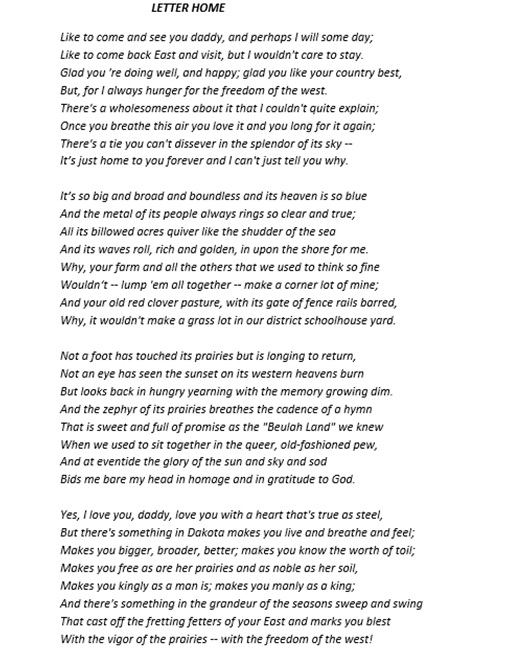
James W. Foley
PLACE NAMES IN NORWAY
Place names in Norway can be confusing, for there are many ways to express where one is from. The Reitens and the Hildres are from all of the following places:
HILDRESTRANDA, an area of rocky seashore or coastline (stranda), about 10 miles long, located about 20 miles north of the city of Aalesund. Ingward Reiten tells of his family coming from the farm of Reiten on the on the . . .
rocky coast known as HiIdrestranda . . . barren windswept spit of land jutting out into the North Sea, so windswept that no trees grew there. It was just rocks and peat lands, bush and heather, and the sea rolling in. Here they were all fishermen who also maintained small fields among the rocks where they grew barley and oats, potatoes and some hay, and grazed a few cattle and a few sheep on the sathers or summer pastures up in the mountains.
When the children were very young, they crawled down the rocky path to the sea where on calm days they could play in the surf and peer down into the mysteries of the sea bottom, or they could improvise a line and fish or watch the flocks of noisy swooping seagulls. In the summer there was the ever-present daylight, the golden, shimmering light when the sun rolled toward the horizon until it disappeared behind the island of Flem to reappear when it came by the island. The purple heather, the violas, and other wildflowers created a fairyland atmosphere. In winter, the darkness, the storms, the loneliness when the men were away with the fishing fleet, and above all the wind and the pounding sea caused both young and old to feel as if judgment day were at hand. Small wonder that sensitive souls were either wildly happy or deeply depressed.
REITEN, ALVESTAD, HILDRE, farms on Hildrestranda; there are many farms called Hildre. HILDRE is also a community.
ADDITIONAL INFORMATION: Norway Maps
HARAM, an island not far from Hildrestranda. The church was located there and at one time, it was the center of government or parish. HARAM PRESTEGJELD, Haram Parish, included all of Hildrestranda and the surrounding districts. The Reitens and the Hildres are from the parish of Haram.
SONDMORE, similar to a county. Hildrestranda is in Sondmore.
MORE og ROMSDAL, similar to a large county or a district.
AALESUND, the largest city (over 40,000 population), and the largest fishing port in western Norway. As the crow flies, it is about 15-20 miles from Hildre to Aalesund, but with the winding roads around and through mountains, the distance is about 50 miles.
THE REITEN AND THE HILDRE FAMILIES¶
It is not easy to trace the Reitens and the Hildres in Norway, for family names would change as ownership of farms changed. The Haram Bygdebok (bygd = country, district, parish) an early history of the farms of Haram, includes an account of farm #26, Reiten, which was an old farm mentioned in the year 1600. For a time in the 1700s, it was a part of farm #27, Alvestad, until they were separated in 1771. It was farmed by cotters or tenants with life tenure who often had to pay as many taxes as if they were landowners. "With the assessment of 1771, it was ordered that the farm of Reiten should pay all ordinary and extraordinary taxes and one calf hide in conscription tax for naval defense." Before 1800 there was never more than one farmer on Reiten, which was owned by Borgund Parish from the middle ages until the 1800s. It seems that the king owned all the land in the middle ages; then, to finance his army, sold it to the churches. It is unknown how the families obtained possession of it after that.
However, Reiten was inherited by ANNA NILSDATTER (1789-1850), daughter of Nils Olsen of Synnaland, an only child, who married JETMUND OLSEN SYNNALAND, son of Ole Jetmundsen Helland, also from Synnaland. At that time, four farmsteads were in one group in Synnaland. When Anna and Jetmund moved to Anna's farm and took the name of Reiten, the old family relationship returned to the farm. They leased the farm for their lifetime from the Borglund Church. Jetmund Olsen and Anna Nilsdatter were the paternal grandparents of Hans O. Reiten.
Jetmund and Anna had at least three sons and may have had other children as well. The first son was Jetmund Jetmundsen Sonderland, born in 1800, who married Inger Myskje Harumsoy; they inherited the Arne-gard, the farm. Jetmund was a well-informed man who often visited the sick and the elderly and would read to them. The second son, Nels Jetmundsen (Sonderland) Grytten, was born in 1802.
A third son, OLE JETMUNDSEN ALVESTADREIT, better known as Reit Ola, born in 1805, was to become Hans's father. He and his wife, INGER (ENGE) SJURSDATTER AAKRE, had their own farm on Alvestad-Reiten. Reit Ola was considered the first layman or lay preacher of that district, apparently an adherent of the lay preacher/revivalist Hans Nielsen Hauge (1771—1824) who de-emphasized ritual and hierarchy and stressed holy living. Reit Ola gathered people in homes and conducted religious meetings. It was told that one Sunday morning, Ola walked from Alvestad to the Vatne Church and took part in the services. Afterward he talked to the people in the church yard, and then walked home to Alvestad. After being encouraged by the parish priest and with the blessing of the bishop, Reit Ola opened a weather station in 1870 on Haram; from there fishermen left to go fishing. No doubt it was from his father that Hans learned to read the skies to predict the weather. Reit Ola died in 1875 as a karman, a retired farmer who when he turned over the farm to his heir, was guaranteed a home and food for the rest of his life.
Ole Jetmundsen and Inger Sjursdatter had several children, among them, HANS KNUD MARTINUS OLSEN REITEN. According to Carl Alvestad, who worked for Peter I. Reiten many years ago, they had five sons and two daughters: Knute, Nels, Iver, Andreas, Hans, Anna, and Hellena. As far as is known, Hans was the only one of their children to leave Norway for a new home in America. However, their son Knute had three sons and one daughter who emigrated, while Iver had four sons who emigrated, all of them to the Petersburg, ND, area. Their son, Nels, had a whaling fleet that sailed great distances, even as far as the North Pole. On one of his trips, he and his crew found the remains of Amundson's plane which had been forced down 136 miles short of the pole. Nels took the name, Alvestad, and moved to Hareid, Norway. When Hans died in 1934, his obituary noted that he had one brother in Hareide, Norway; very likely this was Nels. Nothing is known of Andreas, also one of their sons. One of their daughters, Anna, married Knut P. Alvestad and lived on the Petter-garden on AIvestad. They have a large relationship. Their daughter, Hellena, married Albert Estbro.
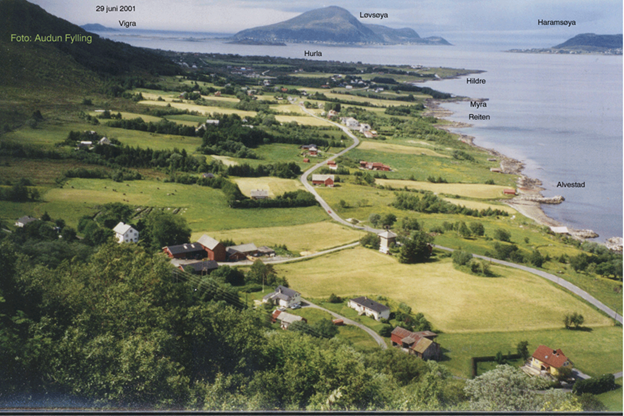
HILDRESTRANDA, NORWAY:
Knute Alvestad farm, lower right
Reiten and Hildremyr farms, upper middle
Hildre farms, upper right
In a booklet, Grytaslekta, which was printed around 1948, the Gryta family line is traced back for several centuries. Though the booklet contains a number of known inaccuracies, no doubt the general pattern of what is there is correct. A chart which summarizes the contents of that booklet is included here. It is from this Gryta family that WILHELMINE CAROLINE KARN MARTINUSDATTER HILDRE comes, for her mother was Berte Nilsdatter Gryta who married Martinus Nilsen Hildre. Martinus and Berte Nilsdatter Gryta Hildre had four daughters and three sons: Nikolina, Nil s, Wilhelmine, Andreas, Hans, Marta, and Anna. Of these, Wilhelmine and her two youngest sisters, Marta and Anna, were to emigrate to the United States and settle in the Petersburg area. In addition, several of her nieces and nephews, the children of her brothers, Andreas and Hans, also emigrated to the United States in time. Most of the other members of her family spent their lives in or near Brattvag, Norway.

Hildre History¶
Paternal Ancestry of Ole Petersen Hildre¶
Iver Jakobsen (1677- ) and Siri Iversdatter ( - )¶
Iver Jakobsen was born in 1677.
Iver married Siri Iversdatter on 3 Jan 1717 in Haram, More ag Romsdahl, Norway. They had seven children: Jacob, Elling, Kari, Marthe, Iver, Marte, and Just.
The children of Iver Jakobsen and Siri Iversdatter were:
Jacob Iversen was born on 29 Sep 1717 in Haram, More og Romsdahl, Norway.
Jacob married Ingelef on 1 Nov 1742 in Haram, Norway.
Elling Iversen was born in 1725.
Elling married Guri Pedersdatter on 14 Jul 1743 in Bremsnes, More og Romsdal, Norway. Guri was born in Halas, More og Romsdal, Norway. They had two children: Ane and Jacob.
Kari Iversdatter.
Marthe Iversdatter was born on 11 Feb 1727 in Haram, More og Romsdahl, Norway and died in 1727 in Haram, More og Romsdahl, Norway.
Iver Iversen was born on 31 Mar 1729 in Haram, More og Romsdahl, Norway.
Marte Iversdatter was born in 1732.
Just Iversen was born in 1736.
Just married Brite Pedersdatter on 21 Jan 1758 in Hildrestranda, More og Ramsdal, Norway. Brite was born in 1740. They had seven children: Siri, Brite, Jacob, Peder, Karen, Ragnhild, and Berte Marie.
Just Iversen (1736- ) and Brite Pedersdatter (1740- )¶
Just Iversen, son of Iver Jakobsen and Siri Iversdatter, was born in 1736.
Just married Brite Pedersdatter on 21 Jan 1758 in Hildrestranda, More og Ramsdal, Norway. Brite was born in 1740. They had seven children: Siri, Brite, Jacob, Peder, Karen, Ragnhild, and Berte Marie.
The children of Just Iversen and Brite Pedersdatter were:
Siri Justesdatter was born in 1757.
Brite Justesdatter was born on 26 Feb 1768 in Haram, More og Romsdahl, Norway.
Jacob Justesen was born on 3 Mar 1771 in Haram, More og Romsdahl, Norway and died in 1836 at age 65.
Jacob married Kari Andersdatter. Kari was born in 1766. They had two children: Iver and Johanne.
Peder Justesen was born in 1776.
Karen Justesdatter.
Ragnhild Justesdatter was born on 6 Feb 1780 in Haram, More og Romsdahl, Norway.
Ragnhild married Didrich Knudsen on 9 Jun 1816 in Haram, More ag Romsdahl, Norway. Didrich was born in 1782.
Berte Marie Justesdatter was born in 1782.
Berte married Anders Knudsen.
Jacob Justesen (1771-1836) and Kari Andersdatter (1766- )¶
Jacob Justesen, son of Just Iversen and Brite Pedersdatter, was born on 3 Mar 1771 in Haram, More ag Romsdahl, Norway and died in 1836 at age 65.
Jacob married Kari Andersdatter. Kari was born in 1766. They had two children: Iver and Johanne.
The children of Jacob Justesen and Kari Andersdatter were:
Iver Jacobsen was born on 13 Aug 1798 in Haram, More ag Romsdahl, Norway and died on 9 Jun 1857 in Haram, More ag Romsdahl, Norway at age 58.
Iver married Olave Pedersdatter on 31 Jul 1825 in Haram, More ag Romsdahl, Norway. Olave was born in 1800. They had four children: Pernille Bertine, Peter Magnus, Jacobine Marie, and Johan Martinus.
Johanne Jacobsdatter was born on 7 Oct 1802.
Iver Jacobsen(1798-1857) and Olave Pedersdatter(1800- )¶
Iver Jacobsen, son of Jacob Justesen and Kari Andersdatter, was born on 13 Aug 1798 in Haram, More ag Romsdahl, Norway and died on 9 Jun 1857 in Haram, More ag Romsdahl, Norway at age 58.
Iver married Olave Pedersdatter on 31 Jul 1825 in Haram, More ag Romsdahl, Norway. Olave was born in 1800. They had four children: Pernille Bertine, Peter Magnus, Jacobine Marie, and Johan Martinus.
Pernille Bertine Iversdatter was born on 25 May 1828 in Haram, More og Romsdahl, Norway and died on 18 May 1832 in Haram, More ag Romsdahl, Norway at age 3.
Peter Magnus Iversen was born on 22 May 1832 in Harham Sogn Praestgjeld, More og Romsdal, Norway, died on 1 Feb 1926 in Haram kommune, Møre og Romsdal fylke, Norway at age 93, and was buried in Hildre Cemetery.
Peter married Karn Gurine Berentsdatter Flem, daughter of Berent Pedersen Flem and Hellene Olave Larsdatter, on 29 Jun 1862 in Harham Sogn Praestgjeld, More og Romsdal, Norway. Karn was born in 1838 in Harham Sogn Praestgjeld, More og Romsdal, Norway. They had seven children: Iver Olaus Petersen, Berent Petersen, Ole Petersen, Hans Berent Martin Pettersen, Oluf Hans Peter Pettersen, Lina Karen Anna Petersdatter, and Hansine Petrine.
Jacobine Marie Iversdatter Hildre was born on 20 May 1836 in Haram, More ag Romsdahl, Norway, died on 26 Apr 1922 in Haram kommune, Møre og Romsdal fylke, Norway at age 85, and was buried in Hildre Cemetery.
Jacobine married Rafael Britanus Knudsson Alvestad, son of Knud Rafaelsen Knudsen, on 18 Jun 1871 in Haram, Norway. Rafael was born in 1846, died in 1909 in Haram kommune, Møre og Romsdal fylke, Norway at age 63, and was buried in Hildre Cemetery.
Johan Martinus Iverson Skjelten was born on 21 Jul 1842 in Haram kommune, Møre og Romsdal fylke, Norway, died on 10 Jul 1928 in Haram kommune, Møre og Romsdal fylke, Norway at age 85, and was buried in Hildre Cemetery.
Johan married Helene Laurentze Jacobsdatter, daughter of Jacob Mortensen, on 15 Jun 1873 in Haram, Norway. Helene was born in 1849.
Johan next married Karoline Kristine Olsdatter Rogne on 5 Sep 1886 in Haram, Norway. Karoline was born on 19 Sep 1850 in Haram kommune, Møre og Romsdal fylke, Norway, died on 27 Oct 1923 in Haram kommune, Møre og Romsdal fylke, Norway at age 73, and was buried in Hildre Cemetery.
Peter Magnus Iversen (1832-1926) and Karn Berentsdatter (1838- )¶
Peter Magnus Iversen, son of Iver Jacobsen and Olave Pedersdatter, was born on 22 May 1832 in Harham Sogn Praestgjeld, More og Romsdal, Norway, died on 1 Feb 1926 in Haram kommune, Møre og Romsdal fylke, Norway at age 93, and was buried in Hildre Cemetery.
Peter married Karn Gurine Berentsdatter Flem, daughter of Berent Pedersen Flem and Hellene Olave Larsdatter, on 29 Jun 1862 in Harham Sogn Praestgjeld, More og Romsdal, Norway. Karn was born in 1838 in Harham Sogn Praestgjeld, More og Romsdal, Norway. They had seven children: Iver Olaus Petersen, Berent Petersen, Ole Petersen, Hans Berent Martin Pettersen, Oluf Hans Peter Pettersen, Lina Karen Anna Petersdatter, and Hansine Petrine.
The children of Peter Magnus Iversen and Karn Gurine Berentsdatter Flem were:
Iver Olaus Petersen Hildre was born on 8 Aug 1864 in Haram, More og Romsdal, Norway, died on 20 Nov 1921 in Haram, More og Romsdal, Norway at age 57, and was buried in Hildre Cemetery.
Iver married Kristine Vilhelmine Hansdatter on 2 Jul 1893 in Haram, More og Romsdal, Norway. Kristine was born on 31 May 1870 in Haram, More og Romsdal, Norway, died on 5 Jun 1942 in Haram, More og Romsdal, Norway at age 72, and was buried in Hildre Cemetery. They had seven children: Peter Iversen, Petra Iversdatter, Karen Iversdatter, Hilda, Gina, Helga, and Ragna.
Berent Petersen Hildre was born on 18 May 1867 in Haram, More og Romsdal, Norway, died on 21 Mar 1939 in Haram kommune, Møre og Romsdal fylke, Norway at age 71, and was buried in Hildre Cemetery.
Berent married Josefine Gina Ingeborg Gundersdatter, daughter of Gunder Gundersen, on 8 Jul 1888 in Haram kommune, Møre og Romsdal fylke, Norway. Josefine was born on 24 Dec 1869, died on 8 Sep 1924 in Haram kommune, Møre og Romsdal fylke, Norway at age 54, and was buried in Hildre Cemetery. They had four children: Gina, Karn Petra, Hjordis and Borghild Josefine.
Ole Petersen Hildre was born on 18 Feb 1870 in Hildrestranda, Sondmore, Norway, died on 6 Oct 1952 in Petersburg, Nelson County, North Dakota at age 82, and was buried in Petersburg City Cemetery, Petersburg, North Dakota.
Ole married Berthine "Tina" Enga Josephine Reiten, daughter of Hans Knud Martinus Olsen Reiten and Vilhelmine Caroline Karn Martinusdotter Hildre, in Jun 1896 in Lakota, North Dakota. Berthine was born on 20 Nov 1878 in Hildrestranda, Sondmore, Norway, died on 4 Oct 1942 in Grand Forks, North Dakota at age 63, and was buried on 7 Oct 1942 in Petersburg, Nelson County, North Dakota. They had five children: Peter Carl, Hartvig "Bo" Wilhelm, George Bert, Conrad, and Wilhelmina Karen.
Hans Berent Martin Pettersen Hildre was born on 18 Mar 1873 in Haram, More og Romsdal, Norway and died on 4 Jun 1881 in Haram kommune, Møre og Romsdal fylke, Norway at age 8.
Oluf Hans Peter Pettersen Hildre was born on 1 May 1876 in Hildestranda, Sondmore, Norway, died on 18 Nov 1961 in North Dakota at age 85, and was buried in Petersburg City Cemetery, Petersburg, North Dakota.
Oluf married Mabel Johnson. Mabel was born on 22 Oct 1885 in North Dakota, died on 31 Dec 1969 in North Dakota at age 84, and was buried in Petersburg City Cemetery, Petersburg, North Dakota. They had one daughter: Clarice. Olaf and Mabel Hildre
Lina Karen Anna Petersdatter Hildre was born on 2 Oct 1879 in Hildrestranda, More og Ramsdal, Norway, died on 14 Dec 1972 in Petersburg, Nelson County, North Dakota at age 93, and was buried in Petersburg City Cemetery, Petersburg, North Dakota. Nisse Folk Tale
Lina married Martin Hildremyr about 1911 in Petersburg, Nelson County, North Dakota. Martin was born in Mar 1882 in Norway, died on 22 Dec 1970 in Petersburg, Nelson County, North Dakota at age 88, and was buried in Petersburg City Cemetery, Petersburg, North Dakota. They had five children: Obert, Peter Carl, Clarice, George, and Mildred J.
Hansine Petrine Petersdatter was born on 26 Jul 1884 in Haram, More og Romsdal, Norway and died on 2 Mar 1886 in Hildestranda, Sondmore, Norway at age 1.
Ole Petersen Hildre (1870-1952) and Berthine Reiten (1878-1942)¶
Ole Petersen Hildre, son of Peter Magnus Iversen and Karn Gurine Berentsdatter Flem, was born on 18 Feb 1870 in Hildrestranda, Sondmore, Norway, died on 6 Oct 1952 in Petersburg, Nelson County, North Dakota at age 82, and was buried in Petersburg City Cemetery, Petersburg, North Dakota.
Ole married Berthine "Tina" Enga Josephine Reiten, daughter of Hans Knud Martinus Olsen Reiten and Vilhelmine Caroline Karn Martinusdotter Hildre, on Jun 1896 in Lakota, North Dakota. Berthine was born on 20 Nov 1878 in Hildrestranda, Sondmore, Norway, died on 4 Oct 1942 in Grand Forks, North Dakota at age 63, and was buried on 7 Oct 1942 in Petersburg, Nelson County, North Dakota. They had five children: Peter Carl, Hartvig "Bo" Wilhelm, George Bert, Conrad, and Wilhelmina Karen.
The children of Ole Petersen Hildre and Berthine Enga Josephine Reiten were:
Peter Carl Hildre was born on 3 Jun 1898 in Nelson County, North Dakota, died on 25 Feb 1976 in Cooperstown, North Dakota at age 77, and was buried in Petersburg City Cemetery, Petersburg, North Dakota.
Peter married Edith Arneson, daughter of Carl J. Arneson and Caroline Arneson, on 9 May 1932 in Petersburg, Nelson County, North Dakota. Edith was born in 1904 in Petersburg, Nelson County, North Dakota, died in Jun 1945 in Lakota, North Dakota at age 41, and was buried in Doyon, North Dakota.
Hartvig "Bo" Wilhelm Hildre was born on 23 Sep 1899 in Petersburg, Nelson County, North Dakota, died on 29 Aug 1975 in Cooperstown, North Dakota at age 75, and was buried on 2 Sep 1975 in Cooperstown, North Dakota.
Hartvig married Edith Mae Hicks, daughter of George Hicks and Sarah Smith, on 15 Oct 1938 in Pierre, South Dakota. Edith was born on 17 Mar 1916 in Charbonneau, North Dakota, died on 21 Oct 1996 in Cooperstown, North Dakota at age 80, and was buried in Cooperstown, North Dakota. They had two children.
George Bert Hildre was born on 26 Jun 1902 in Petersburg, Nelson County, North Dakota, died on 13 Mar 1960 in Petersburg, Nelson County, North Dakota at age 57, and was buried in Mar 1960 in Petersburg City Cemetery, Petersburg, North Dakota.
George married Allene Alice Lindquist, daughter of Walter Lindquist and Edith Atkinson, on 16 Jul 1931 in Swanville, Minnesota. Allene was born on 1 Sep 1908 in Barnesville, Minnesota and died on 16 Oct 1986 in Otter Tail, Minnesota at age 78. They had two children.
Conrad Hildre was born on 26 May 1907 in Petersburg, Nelson County, North Dakota and died on 25 Aug 1999 in Sparks, Washoe, Nevada at age 92.
Conrad married Doris Catherine Brown, daughter of George W. Brown and Florence Adele Lewis, on 8 Aug 1929 in Michigan, Nelson, North Dakota. Doris was born on 27 Apr 1910 in Michigan, Nelson, North Dakota, died on 6 Mar 1997 in Sparks, Washoe, Nevada at age 86, and was buried in Reno, Washoe, Nevada. They had four children.
Wilhelmina Karen Hildre was born on 13 May 1914 in Grand Forks, North Dakota, died on 23 Mar 1989 in Fargo, North Dakota at age 74, and was buried in Petersburg, North Dakota.
Wilhelmina married Edwin Arthur Code, son of Milton Edward Code and Edna Louise Potts, on 9 Mar 1946 in Petersburg, North Dakota. Edwin was born on 23 Aug 1913 in Toppenish, Washington, died on 12 Sep 2001 in Williston, North Dakota at age 88, and was buried in Petersburg, North Dakota. They had five children.
OLE PETER HILDRE and BERTHINE ENGA JOSEPHINE REITEN¶
HILDRE, OLE PETER
b. 1870 February 18
d. 1952 October 6 (83 years old)
REITEN, BERTHINE ENGA JOSEPHINE (HILDRE)
b. 1878 November 20
d. 1942 October 4 (63 years old)
BERTHINE ENGA JOSEPHINE REITEN, or Tina as she was always known, was born in Aalesund, Norway, on November 20, 1878, the first daughter and second child of Hans and Wilhelmine Hildre Reiten. She was eight years old when she and her family left Norway in the spring of 1887 and moved to the United States. No doubt she attended the country school near her home during her early years in North Dakota. She also may have attended the two years of high school that Petersburg offered at the time. When she was old enough, Tina worked for a time for a neighbor, but was very homesick.
ADDITIONAL INFORMATION: Petersburg, North Dakota
In June 1896, Tina married OLE PETER HILDRE before Prate Martin, Justice of the Peace in Lakota, ND. She was 17 years old; Ole was 26. Perhaps Ole needed courage to propose to one so young, for the story is that he told Martin, Tina's younger brother, that he was going to ask Tina to marry him before he asked her.
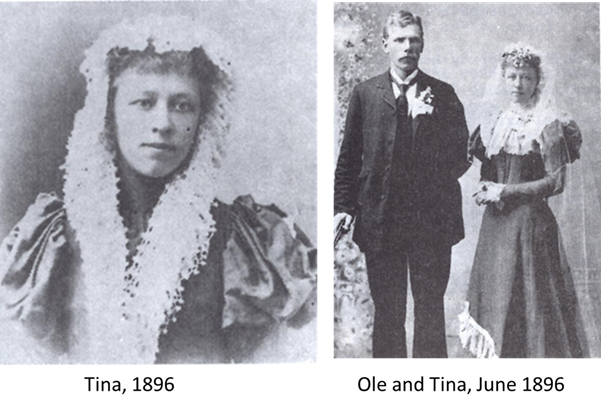
Ole Hildre was born in Hildestranden, Haram, Sondmore, Norway, on February 18, 1870, to Peter and Karen Hildre. At the age of 18, in 1888, he left Norway and came to the Petersburg area. Shortly afterward, he homesteaded the quarter of land which is the site of the present Hildre farm. In time, he was to buy three more quarters of land.
Soon he also became involved in community and business affairs of the town and county.
In 1893, Ole, along with six other newcomers including his brother Oluf, had built the Petersburg Mercantile Company, known as the Big Store. At first, the second floor provided rooms for their sleeping quarters. Ole was active in the operation of this store for many years. No doubt Peter, his oldest son, learned store clerking in this store.
The first home of Tina and Ole was a house they built in Petersburg on the same block as Tina's parents. All of their five children were born while they lived there. The Hildres lived in town until 1918 when Ole sold his interest in the Big Store to his partners and with his family, moved to his farm about four miles south of Petersburg which he operated from then on. He and Tina remained on the farm for the rest of their lives.
Ole continued his involvement in community affairs for much of his active life. Sometime around 1902, Ole, along with Ole H. Reiten, his brother-in-law, Ole K. Reiten, and Ole Sonderland bought a separator, called the Ole Rig, with which they did custom threshing for area farmers.
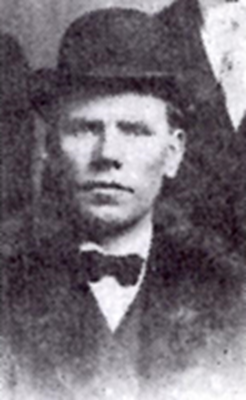
Ole 1908
In the spring of 1908, a Sons of Norway Lodge was organized in Petersburg, the Fridtjof Lodge #80, which had 80 members. Ole Hildre was its first president.
The Hildre family made several trips to Norway to visit their Hildre and Reiten relatives. In 1903, when Ole and his brother Oluf returned to Norway for a visit, they convinced their sister, Lena, who was living in Hildre, Norway, to come to America with them. She lived with Tina and Ole for a time in Petersburg, homesteaded land in McKenzie County for the required 18 months, and later on, returned to Petersburg where she married Martin Hildremyr. After Tina and Ole moved to the farm, Lena and Martin bought the Hildre home in Petersburg.
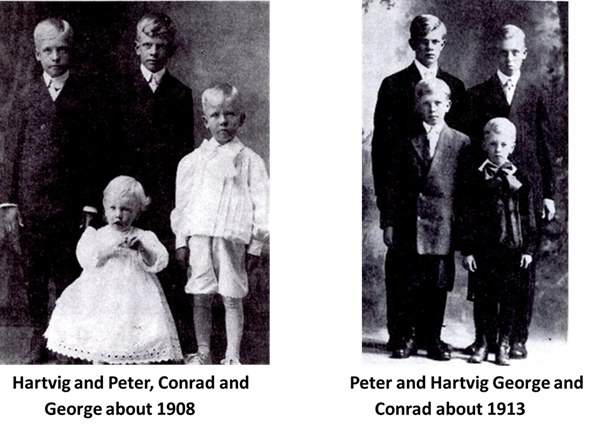
In 1909, Tina and Ole and their three oldest boys, ranging in age from 11 to 7, spent six months in Norway. While they were gone, Tina's parents took care of two-year-old Conrad. The Petersburg Record of October 21, 1909, reports on their travels: "Ole Hildre and Peter I. Flem who with their families have been sojourning in Norway the past 6 months, expect to sail from Liverpool the 23d of this month on the homeward trip. " A little more than three months later, Tina 's parents along with Emma, were to sail for Norway with the intention of staying there.
Ole was a county commissioner for Nelson County for many years in the 1920s and 1930s; he was also a member of the state legislature in the mid-1920s. Whatever office it was he was running for in 1920, Petersburg was behind him, for the Petersburg Record of November 4, 1920, reports, "Ole Hildre runs like whirlwind in Petersburg Village - 145 to 1. In the Township they did not treat him quite so well. They cast 16 votes against him.“ During the years Ole was a county commissioner, the local paper faithfully reported every trip he made to Lakota for meetings. He also served on the Petersburg school board for many years and was a trustee of the Petersburg Lutheran Church for over twenty years.
In 1922, a large group of friends surprised Tina and Ole with a silver wedding celebration. This, too, is reported in the Petersburg Record of June 29, 1922.
About 200 neighbors and friends from all parts of the county gathered at the home of County Commissioner and Mrs. Ole Hildre last Monday afternoon to help them celebrate their 25th wedding anniversary. The gathering was in the nature of a surprise to Mr. and Mrs. Hildre. About 25 cars starting out there together, others joining them later. The ladies took possession of the kitchen and spread a bounteous supper they had brought along and which they served at six. Congratulatory talks were given by Rev. Thos. Anderson, J. O. Engesather, P.E. Johnson, and Prate Martin. Mr. Martin officiated at Mr. and Mrs. Hildre's wedding 25 years ago. Rev. Anderson on behalf of those present, presented Mr. and Mrs. Hildre with a beautiful silver set on a silver tray as a token of esteem in which they are held by their neighbors. A unique feature of the occasion was when an airplane landed at the place. Mr. and Mrs. Hildre were given an airplane ride.
Indeed, this was one of the highlights of the day, when two World War I pilots landed a Jenn airplane in the pasture near their house and gave Tina and Ole a plane ride. They were the first people from Petersburg to ride in a plane.
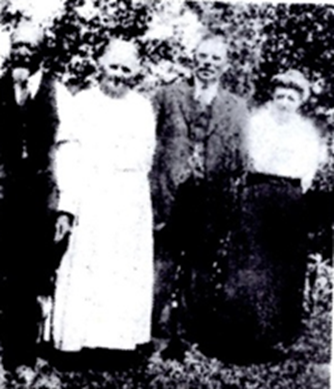
Hans, Wilhelmine, Ole, and Tina probably 1920s
Though Ole "retired" in 1938 when Conrad and his family moved to the farm so Conrad could take over the farming, Tina and Ole continued to live on their farm. In 1942, Peter and Edith moved to the farm. That year, Tina and Ole began making plans to leave the farm and moved into Petersburg to live with Emma in the big house, for Wilhelmine had died in July of that year, and Emma was alone. But Tina, who was not well, died in the Deaconess Hospital in Grand Forks of diabetes and hardening of the arteries on October 4, 1942, at the age of 63.

Ole died at his farm home on October 6, 1952, at the age of 82 years. Both Tina and Ole are buried in the Petersburg cemetery. Each of their four sons received a quarter of land at Ole's death; much of this has passed on to their children.
ADDITIONAL INFORMATION: Petersburg City Cemetery
Tina and Ole were known for their warmth and hospitality. Tina was a wonderful cook and hostess and loved to share her home and table with friends and family and neighbors. Tina and Ole had four sons and one daughter, and thirteen grandchildren; they also have twenty-two great grandchildren and ten great, great grandchildren, as of 1984. Ole remained on the farm. In 1944, Conrad and his family moved to California. George and Allene and their children moved to the farm in 1949; in partnership with Peter, they farmed the land until it was put in Soil Bank in 1955.
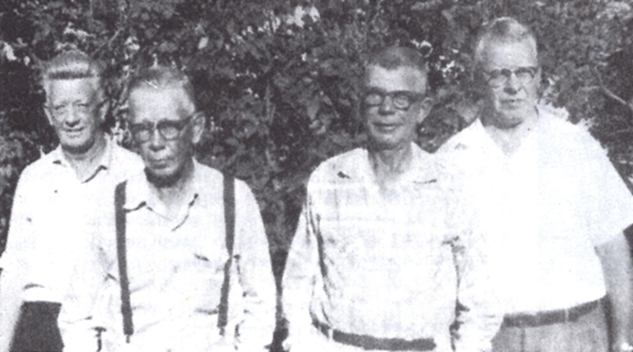
Conrad, Peter, George, Hartvig 1959
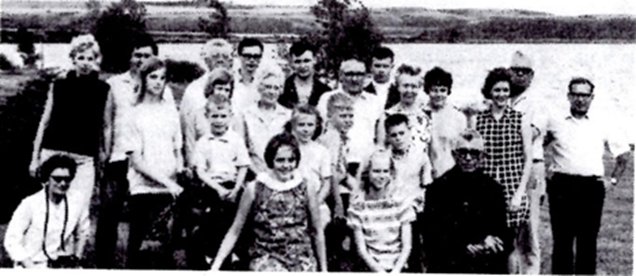
Some of the descendants of Tina and Ole Hildre August 1968
PETER CARL HILDRE
b. 1898 June 3, in Petersburg, ND d. 1976 February 25
m. 1932 May 9, EDITH ARNESON, in Petersburg, ND (1904-1945)
HARTVIG WILHELM (BO) HILDRE
b. 1899 September 23, in Petersburg, ND d. 1975 August 29
m. 1938 October 15, EDITH MAE HICKS, in Aberdeen, SD (1916-1996)
TWO CHILDREN
GEORGE BERT HILDRE
b. 1902 June 26, in Petersburg, ND d. 1960 March 13
m. 1931 July 16, ALLENE LINDQUIST, in Swanville, MN (1908-1986)
TWO CHILDREN
CONRAD HILDRE
b. 1907 May 26, in Petersburg, ND d. 1999 Aug29
m. 1929 August 8, DORIS CATHERINE BROWN, in Michigan, ND (1910-1997)
FOUR CHILDREN
WILHELMINA KAREN HILDRE (CODE)
b. 1914 May 13, in Grand Forks, ND d. 1989 Mar 23
m. 1946 March 9, EDWIN ARTHUR CODE, in Petersburg, ND (1913-2001)
FIVE CHILDREN
Hildre Photos¶
PHOTOS: Hildre Photos
PHOTOS: Ole and Tina Hildre
PHOTOS: Ole and Tina Hildre Family
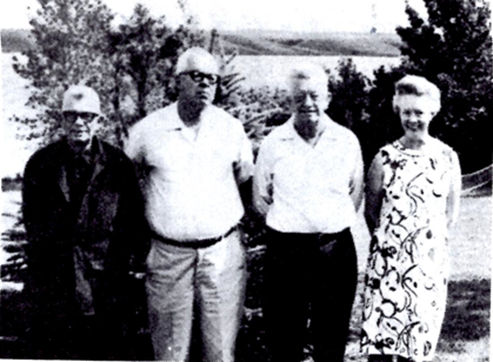
Peter, Bo, Conrad, Wilma, August 1968
PETER CARL HILDRE¶
HILDRE, PETER CARL
b. 1898 June 3
d. 1976 February 25 (77 years old)
PETER CARL HILDRE, the first son of Ole and Tina Reiten Hildre, was born in Petersburg, ND, on June 3, 1898, where he grew up. The May 5, 1910, issue of the Petersburg Record reports a close call he had when he was twelve years old. He was injured when a 22 rifle he was handling discharged; the bullet struck him in the chest, glanced upward beneath the skin, and lodged behind his ear. Peter attended grade and high school in Petersburg, where he was a member of the winning basketball team. In 1918, the year the Hildre family moved out to their farm, he was in the third graduating class of the high school.
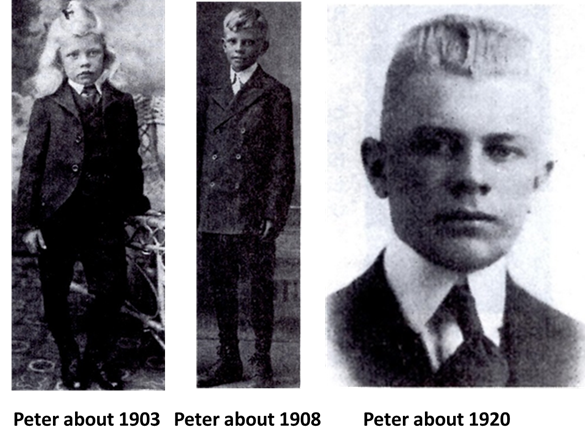
Following his graduation from high school, Peter went to Fargo Business College for about a year, then worked for his uncle, Oluf Hildre, in his mercantile store in Dahlen, ND, during the summer. In the fall of 1919, he enrolled in North Dakota Agricultural College in Fargo, ND, where he played on the A. C. basketball team and was also in ROTC. In time, Hartvig, George, and Wilma were to follow him to the A. C.
After two years of college, Peter returned to Petersburg in 1921 where he worked on the home farm for a time, and then became a clerk in the Petersburg Cash Store. When the store bought the Doyon Mercantile Store, Peter went to Doyon to manage that store. There he met Edith Arneson who was a teacher and a musician and played the organ for church services. Peter managed the Doyon store for three years, then returned to work in the Dahlen store.
Peter and EDITH ARNESON were married in Petersburg, ND, on May 9, 1932; he was 34 years old. The Petersburg Record of May 12, 1932, reports their wedding as follows:
ARNESON - HILDRE
Miss Edith Arneson of Doyon and Peter Hildre of Petersburg were quietly married at the Lutheran Parsonage at eleven o 'clock, Monday morning, Rev. T. M. Rykken officiating. Their attendants were Miss Wilma Hildre and Hartvig Hildre, sister and brother of the groom.
The bride is the daughter of Mr. and Mrs. C. J. Arneson of Doyon, and is a popular and respected young lady, and an accomplished musician. The groom is the son of Mr. and Mrs. Ole Hildre of this place, and has grown to manhood here, graduating from the Petersburg High School, and at that time a member of our famous champion basketball team, later attending the A. C. of Fargo. For three years he was manager of the Cash Store at Doyon and is now with the Dahlen Mercantile Company.
Mr. and Mrs. Hildre left immediately after the ceremony on a short wedding trip to Lake Plantagenet, and on their return will make their home in Dahlen.
Congratulations and best wishes of the community to the newlyweds.
After their marriage, Peter and Edith lived in Dahlen where Peter continued to work in the mercantile store. Over the years Edith was in poor health. One summer, probably around 1940, Edith stayed at the Hildre farm while Conrad and Doris and their girls were living there. The children loved her and remember her playing the piano and singing with them. Because of Edith's ill health, and because of the war, Peter and Edith moved to the Hildre farm around 1942. Later on, Peter again worked in the store in Doyon and would spend weekends at the farm. Edith was to spend months in a convalescent home in Minneapolis. She was in and out of various hospitals, and finally was in a private hospital in Lakota, ND, where she died in June 1945. She is buried in Doyon.
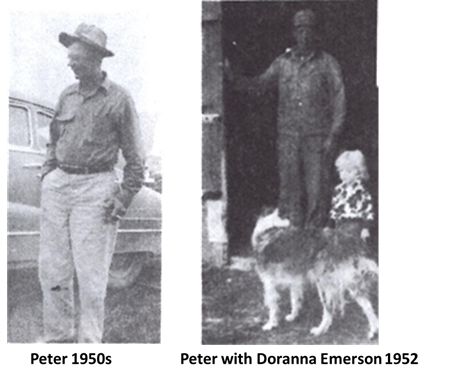
During World War Il, Peter went to Seattle to work in the Boeing Assembly Plant. When the war was over, he returned to Petersburg where he farmed until 1955 when he placed the farm in the Soil Bank Program until 1966. During some of these years, he spent summers on the farm, then would go to Cooperstown during the winters. Peter's health was poor by this time, and he suffered from arthritis. Around 1968 he went to the Deaconess Hospital in Grand Forks for eye surgery; while there he injured his hip and was unable to care for himself. That same year he went to Lisbon where he lived with Wilma and Ed Code for about three years. Around 1971, he entered a rest home in Cooperstown.
On February 25, 1976, in Cooperstown, Peter died of a series of small strokes, at the age of 77 years. He is buried in the Petersburg cemetery.
Descendants of Peter Carl Hildre
Peter Carl Hildre, son of Ole Petersen Hildre and Berthine "Tina" Enga Josephine Reiten, was born on 3 Jun 1898 in Nelson County, North Dakota, died on 25 Feb 1976 in Cooperstown, North Dakota at age 77, and was buried in Petersburg City Cemetery, Petersburg, North Dakota.
Peter married Edith Hazel Arneson on 9 May 1932 in Petersburg, Nelson County, North Dakota. Edith was born in 1904 in Petersburg, Nelson County, North Dakota, died in Jun 1945 in Lakota, North Dakota at age 41, and was buried in Doyon, North Dakota. They had no children. Edith Arneson
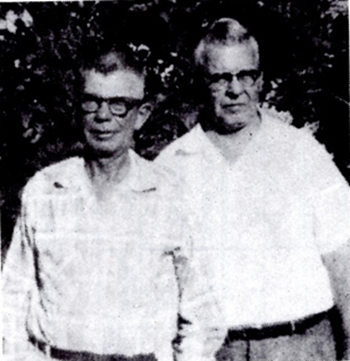
Peter and Hartvig 1959
HARTVIG WILHELM HILDRE¶
HILDRE, HARTVIG WILHELM
b. 1899 September 23
d. 1975 August 29 (75 years old)
HARTVIG WILHELM HILDRE, or Bo as he was called, was born in Petersburg on September 23, 1899, the second son of Ole and Tina Reiten Hildre. He attended both grade and high school in Petersburg where he was active in sports. In his senior year, he was a member of the Petersburg basketball team which won the 1919 state championship by defeating Mandan 19—8; this is the only Petersburg team that has ever won a state championship. State Champions At that time, the competition included schools of all sizes. The Petersburg team had defeated Minot 31-21 in the semi-finals. Following his graduation from high school in 1919, Hartvig attended North Dakota Agricultural College in Fargo for three years, 1919-1922, where he was on the A. C. basketball team. For a time, he worked with the J. I. Case Company in the western part of North Dakota.
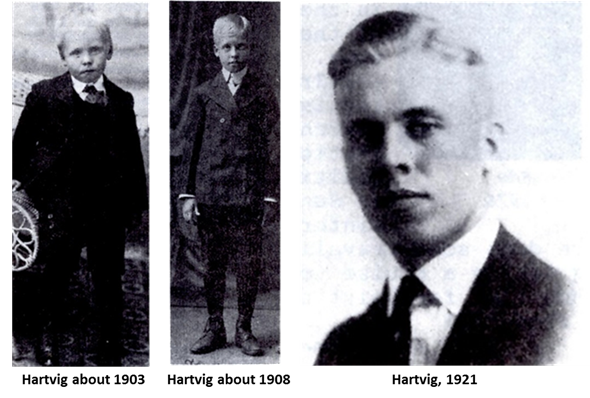
On June 1, 1926, Bo, along with his uncle, Oluf Hildre and A. E. Iverson as shareholders, opened the Petersburg Oil Company, a bulk station with two 15,000-gallon storage tanks. Bo was the manager of this company for two years; in 1928, Conrad, Bo’s youngest brother, became manager.
Over the next years, Bo worked in various places in farm-oriented federal agencies. According to the Petersburg Record, he was working in Ryder, ND in 1928. In 1933, he began working in Bismarck; it was at this time that he met Edith Hicks. In 1934, he also worked as a salesman for the International Implement Company in Nelson County. And in 1935, he was employed in Watford City, ND. On October 15, 1938, at the age of 39, Hartvig married EDITH MAE HICKS in Aberdeen, SD. Edith, or Ede as she was called, was born on March 17, 1916, in Charbon Township, ND, to George and Sarah Smith Hicks. She had attended school in Mandan, ND, and had done clerical work before her marriage.
Following their marriage, Bo and Ede lived in several places - Bismarck, Lincoln, ND, and Valley City, ND - while Bo continued working in various federal farm programs. Then when the John Deere Agency in Cooperstown, ND, was put up for sale in 1945, Bo and several others bought it. The following year, Bo became the sole owner, and Hildre Implement Company was born in 1946. Ede worked as bookkeeper for the company. Business was good and life was good for the Hildres of Cooperstown. Bo retired in the mid 1960s, and his son, Jon, took over the company.

Jon, Ede, Hartvig, Diane and Gary 1966
Bo and Ede continued to live in Cooperstown after their retirement. For several winters, they went to Arizona and California, but most of all, they enjoyed renovating and living in their cabin at Lake Ashtabula south of Cooperstown.
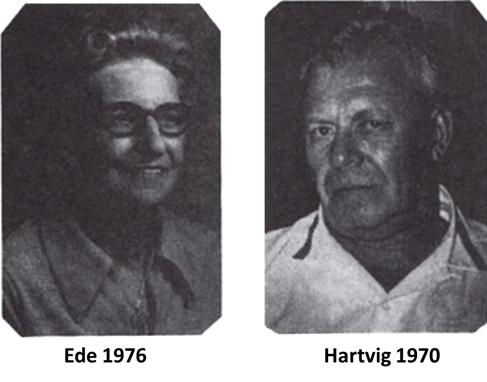
On August 29, 1975, Hartvig died of cancer in Cooperstown. Some time later, Ede sold their old home and built a new smaller house where Jon has an apartment in the basement. In the summer, hers is one of the loveliest yards in town. She is a deacon in the Trinity Lutheran Church and is very active in church and community organizations. Ede enjoys visiting her sister Ethel in San Francisco in the winter. Together they have done some traveling throughout the United States, including taking a cruise to Alaska several years ago. She also finds time for knitting and quilting.
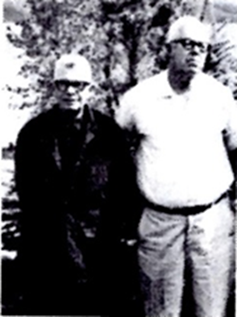
Peter and Hartvig August 1968
Descendants of Hartvig "Bo" Wilhelm Hildre
Hartvig "Bo" Wilhelm Hildre, son of Ole Petersen Hildre and Berthine "Tina" Enga Josephine Reiten, was born on 23 Sep 1899 in Petersburg, Nelson County, North Dakota, died on 29 Aug 1975 in Cooperstown, North Dakota at age 75, and was buried on 2 Sep 1975 in Cooperstown, North Dakota.
Hartvig married Edith Mae Hicks on 15 Oct 1938 in Pierre, South Dakota. Edith was born on 17 Mar 1916 in Charbonneau, North Dakota, died on 21 Oct 1996 in Cooperstown, North Dakota at age 80, and was buried in Cooperstown, North Dakota. Edith Hicks
Children from this marriage were:
Jon Hartvig Hildre was born on 28 Sep 1940 in Bismarck, North Dakota, died on 3 Aug 2017 in Fargo, North Dakota at age 76, and was buried in Cooperstown, North Dakota. Jon Hildre
Diane Edith Hildre was born on 28 Aug 1942 in Bismarck, North Dakota and died on 28 Sep 2021 in Fargo, North Dakota at age 79. Diane Hildre
Diane married Gary Warren Cowdrey on 1 Sep 1966 in Santa Monica, California. Gary was born on 17 Sep 1939 in Cooperstown, North Dakota and died on 26 Nov 2017 in Fargo, North Dakota at age 78. They had one child.
GEORGE BERT HILDRE¶
HILDRE, GEORGE BERT
b. 1902 June 26
d. 1960 March 13 (57 years old)
GEORGE BERT HILDRE was born on June 26, 1902, in Petersburg, ND, the third son of Ole and Tina Reiten Hildre. He grew up in Petersburg where he attended school. Though he was very young at the time, he always remembered the trip to Norway with his family when he was just six years old. Following his graduation from Petersburg High School in 1921, George taught in a country school near Lakota, ND, for two years, 1922 - 1924.
In 1924, George enrolled in the North Dakota Agricultural College in Fargo and graduated on June 11, 1928, with a B.S. degree in agriculture. During his senior year in college he was president of the Alpha Gamma Rho fraternity. The April 7, 1927 issue of the Petersburg Record reports the following:
HILDRE HEAD OF ALPHA GAMMA RHO FRATERNITY
The Alpha Gamma Rho agricultural and social fraternity recently held election of officers. In this election George Hildre of Petersburg was named head of the organization.
Hildre is a junior in the A. C. and a member of the Saddle and Sirloin Club, an organization of the Ag students devoted to the interests of agriculture in the State.
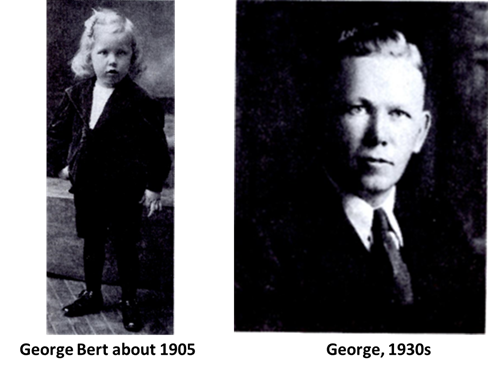
In the summer of 1927, George received an appointment by the U.S. Department of Agriculture for a position with the barberry eradication force assigned to North Dakota; his territory was Pierce County. Then for five years, 1929 - 1934, he taught agriculture and coached in Egeland, ND. It was while he was in Egeland that he met Allene Lindquist.
George and ALLENE LINDQUIST were married in Swanville, MN, on July 16, 1931. He was 29 years old and she was 23. Allene, the daughter of Walter and Edith Atkinson Lindquist, was born on September l, 1908, in Barnesville, MN, where she also went to school for a time. She graduated from Long Prairie High School, then took a one-year teacher training program at St. Cloud State Teachers College, St. Cloud, MN. She taught for a year in a rural school.
After their marriage, George and Allene lived in Egeland where George continued teaching agriculture and coaching. In 1934, they moved to Fosston, MN, where George taught agriculture for two years.
In the summer of 1936, George and Allene and their son left Fosston for Elbow Lake, MN, where George became the county agricultural agent of Grant County, a position he held for nine years, until 1945. Beginning in 1946, George was the Veterans' Agricultural teacher in Elbow Lake for three years. During the 1940s, too, George was a member of the Elbow Lake School Board. Altogether, the Hildres made their home in Elbow Lake for thirteen years.

In 1949, George and Allene moved back to the Hildre farm south of Petersburg where Ole, his father, and Peter, his brother, were living. Here George returned to farming in partnership with Peter. In 1955, they put the farm in Soil Bank.
During the 1955-1956 school year, both George and Allene began teaching in the Petersburg school: George taught agriculture and science, and Allene taught in the grade school. However, George taught only briefly before illness forced him to quit. Allene taught until 1960.
On March 13, 1960, George died of a stroke in Petersburg at the age of 57. He is buried in the Petersburg Cemetery.

George and Allene, May 1958
Following George's death, Allene moved to Fergus Falls, MN. In 1965, she married Arthur Ackerson.
She and her husband lived at Ten Mile Lake near Dalton, MN
George and Allene had one son and one daughter. They have five grandchildren and one great grandchild, as of 1984.
Descendants of George Bert Hildre
George Bert Hildre, son of Ole Petersen Hildre and Berthine "Tina" Enga Josephine Reiten, was born on 26 Jun 1902 in Petersburg, Nelson County, North Dakota, died on 13 Mar 1960 in Petersburg, Nelson County, North Dakota at age 57, and was buried in Mar 1960 in Petersburg City Cemetery, Petersburg, North Dakota.
George married Allene Alice Lindquist on 16 Jul 1931 in Swanville, Minnesota. Allene was born on 1 Sep 1908 in Barnesville, Minnesota and died on 16 Oct 1986 in Otter Tail, Minnesota at age 78. Allene Lindquist
Children from this marriage were:
George Walter Hildre was born on 17 Nov 1933 in Sarles, North Dakota.
George married Donna Jean Harmon on 30 Jul 1955 in Petersburg, Nelson County, North Dakota. Donna was born on 21 Jul 1936 in North Dakota and died on 6 Dec 2001 in Coon Rapids, Minnesota at age 65. They had four children.
George next married Carrol Ann Iverson Adamson on 18 June 2005 in Coon Rapids, Minnesota. Carrol was born on 12 Jan 1934 in Petersburg, Nelson County, North Dakota.
Janet Allene Hildre was born on 19 Sep 1939 in Elbow Lake, Minnesota and died on 19 Nov 1990 in Fosston. Minnesota at age 51. Janet Hildre
Janet married Marvin James Haugen on 10 May 1975 in Fergus Falls, Minnesota. Marvin was born on 8 Feb 1934 in Rice Township, Clearwater County, Minnesota, died on 2 Feb 1996 in Polk County, Minnesota at age 61, and was buried in Fosston, Minnesota. They had one child.
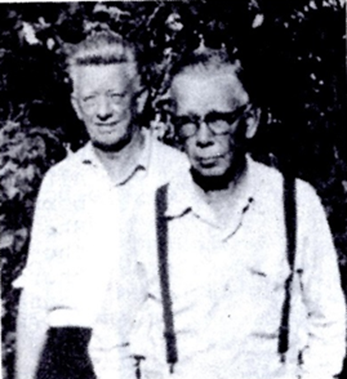
Conrad and George, 1959
CONRAD HILDRE¶
HILDRE, CONRAD
b. 1907 May 26
d. 1999 Aug 25
CONRAD HILDRE, the fourth son of Ole and Tina Reiten Hildre, was born in Petersburg, ND, on May 26, 1907. When his parents and older brothers spent more than six months in Norway in 1909, Conrad stayed with his Reiten grandparents, Hans and Wilhelmine. He grew up in Petersburg with three brothers to keep him in line and to teach him all they knew. When he was eleven years old, in 1918, he and his family moved out to the Hildre farm where they lived from then on. Around that time, his Uncle Nels came home on leave from Pensacola Naval Base; Conrad still remembers how exciting he found the stories of flying that Nels told them.

Conrad and George about 1908
In 1921-1922, when Conrad was a freshman in high school, he was involved in many activities. In February 1922, the Literary Society Program honoring Lincoln and Washington, included "Sayings from Washington,” by Conrad Hildre. The March 9, 1922, issue of the Petersburg Record, called "Pioneer Issue,” was published by the PHS English Department; students wrote all the copy, solicited the advertising, and collected the bills. Conrad's article, "The County Road, " on the county commissioners decision to build a county road from Petersburg to Aneta, appeared in this issue. No doubt his very active county commissioner father provided him with inside information on the topic. In April of 1922, when the first Boy Scout troop was organized in Petersburg, Conrad was elected a patrol leader. And it was in 1922 that Conrad built the first radio to operate in Petersburg.
Following his graduation from high school in 1925, Conrad attended the School of Science in Wahpeton and graduated from there. In 1927 he began working at the Petersburg Oil Company which his brother Hartvig and others had opened the previous year. That same year, he built a radio broadcasting set which has the distinction of being Petersburg's first and only broadcasting station. Older residents still recall listening to it throughout one winter. Conrad became the manager of the oil company in 1928, and was to work there for ten years.

On August 8, 1929, Conrad and DORIS CATHERINE BROWN were married in Michigan, ND. Conrad was 22 years old and Doris, 19. Doris, the daughter of George W. and Florence A. Lewis Brown of Michigan, ND, was born on April 27, 1910, and had lived all her life in Michigan where she also went to school.
Following their marriage, Conrad and Doris lived in Petersburg where Conrad continued to manage the Petersburg Oil Company. It was from 1934—1936 that the Hildres lived in the Martin Loken home in Petersburg. In 1938, they moved to the home farm where they lived with Tina and Ole, and Conrad took over the farming, for Ole had retired by then.
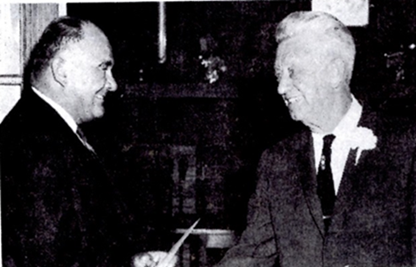
Conrad receiving an award 1962
In 1944, Conrad and his family moved to Herlong, CA, where Conrad became a munitions handler at the Sierra Army Depot, an ordnance depot where ammunition is stored. The country was in the midst of World War Il, and things were moving fast and furiously. The story is that he was given a pair of pliers and a screwdriver and told, "Do as we tell you or you'll get your head blown off. " He did as he was told. Actually, Conrad was in charge of the crews that installed, maintained, and broke down all types of bombs and ammunition. In time he designed many machines and tools that are still used in ordinance today. He has received a number of awards for his designs, inventions, and suggestions. While at the ordnance, he attended several schools and completed their courses: West Coast School in Santa Clara, CA, the Ordnance Management Engineering school in Rock Island, IL, and a safety training school in Kentucky. He found his work very interesting, and over the years, has toured most of the ordnance depots in the United States.
During these years in Herlong, Doris also worked in the ordnance depot for two years. Later she worked as a postal clerk for fifteen years, and in a children's nursery for three years.
In 1972, Conrad retired from the depot and he and Doris moved to Sparks, NV, in 1980. There they are near their daughters, Mary and Connie, and have five families of grandchildren to attend to. Family gatherings are special events in the Conrad Hildre family. In 1979 they celebrated a very special event Doris and Conrad's golden wedding anniversary.

Doris, or Dodie, as everyone calls her, keeps very busy with her crocheting and sewing. She has a marvelous green thumb, and also wraps gorgeous packages. All of these talents she shares with the three generations of her family who live near her.
Conrad and Doris are the parents of three daughters. They had one son, Robert Joseph, who was born in 1937, but lived only a few days. He is buried in the Petersburg cemetery. They have ten grandchildren and eleven great grandchildren, as of 1984. When they all get together it is a notable group.

Mary, Doris and Conrad, Flo, and Connie, 1979
Descendants of Conrad Hildre
Conrad Hildre, son of Ole Petersen Hildre and Berthine "Tina" Enga Josephine Reiten, was born on 26 May 1907 in Petersburg, Nelson County, North Dakota and died on 25 Aug 1999 in Sparks, Washoe, Nevada at age 92.
Conrad married Doris Catherine Brown on 8 Aug 1929 in Michigan, Nelson, North Dakota. Doris was born on 27 Apr 1910 in Michigan, Nelson, North Dakota, died on 6 Mar 1997 in Sparks, Washoe, Nevada at age 86, and was buried in Reno, Washoe, Nevada. Doris Brown
Children from this marriage were:
Mary Wilhelmina Hildre was born on 28 Nov 1929 in Petersburg, Nelson County, North Dakota and died on 21 Oct 2015 in Reno, Washoe, Nevada at age 85. Mary Hildre
Mary married Edwin Vurnis Emerson on 26 Mar 1949 in Sparks, Nevada. Edwin was born on 13 Jul 1928 in Wesso, Nevada and died on 14 Sep 1985 in Reno, Washoe, Nevada at age 57. They had two sons and two daughters.
Constance Anne Hildre was born on 2 Sep 1931 in Petersburg, Nelson County, North Dakota and died on 12 Aug 2001 in Reno, Nevada at age 69. Constance Hildre
Constance married Marco William Novack on 14 Jul 1951 in Susanville, California. Marco was born on 29 Apr 1930 in Ruth, Nevada and died on 12 May 2006 in Reno, Nevada at age 76. They had one son and two daughters.
Florence Adele Hildre was born on 3 Nov 1936 in Grand Forks, North Dakota and died on 1 Nov 2007 in Eugene, Oregon at age 70. Florence Hildre
Florence married Emmett Dale Egbert on 19 Jun 1954 in Reno, Nevada. Emmett was born on 24 Dec 1934 in Sterling, Colorado and died on 20 Aug 2021 in Eugene, Oregon at age 86. They had two sons and one daughter.
Robert Joseph Hildre was born on 2 Dec 1937 in Petersburg, Nelson County, North Dakota and died on 12 Dec 1937 in Petersburg, Nelson County, North Dakota.

Standing: Doris and Conrad Hildre's grandchildren with their spouses
Sitting: Doris and Conrad, 1979
WILHELMINA KAREN HILDRE¶
HILDRE, WILHELMINA KAREN (CODE)
b. 1914 May 13
d. 1989 Mar 23
WILHELMINA KAREN HILDRE, or Wilma as she was always known, was the only daughter and the fifth and last child born to Ole and Tina Reiten Hildre. She was born in Forks, ND, on May 13, 1914, and was named for her two grandmothers. Soon she became the much loved little sister to four older brothers. She recalls that before she was old enough to go to school, she was taken to basketball games by George, who was twelve years older than she was, to watch their older high school-age brothers, Pete and Bo, play basketball.
Wilma grew up on the Hildre farm near Petersburg and attended the grade and high schools in town. Sometimes when the weather was bad, she'd stay in town with her Reiten grandparents and sleep upstairs with Emma and Bella. After Doris and Conrad were married in 1929, she'd stay with them. In May 1930, Doris gave her a surprise 16th birthday party with 16 invited guests. For a number of years, the family's Sunday afternoon routine was to drive into Petersburg to see Grandma and Grandpa and Aunt Emma. They would bring a cake they had baked, but more often than not, they would return home with a gallon pail of strawberries from Grandpa's garden.

Wilma graduated from high school in 1932 in the same class as her cousin, Palmer Reiten. Her mother was determined that Wilma should have a college education, so she raised turkeys and saved her cream checks for that purpose; her older brothers also helped along. Wilma chose to attend the North Dakota Agricultural College in Fargo, as had her brothers before her. Her mother had sewed all of Wilma's clothes when she was small, including slips and bloomers made from flour sacks, but these would not do for college. So, when she was getting ready to go to the A. C. in 1934, all her sisters-in-law gave her some of their clothes, and her Aunt Emma helped out, too, from her dress shop in town. Wilma was one of the best-dressed young women in the dorm.
Wilma graduated from NDAC in 1938 with a major in home economics: food and nutrition. Lyndon Loken brought her parents to Fargo for her graduation. She was happy to have reached the end of the four years of college, for those had not been easy years. But she did come away with a degree and with some good friends.
Soon after her graduation, Wilma became a home supervisor with the Farm Security Administration in Lisbon, ND. In 1942, after three years in Lisbon, Wilma quit her job because she felt she wasn't contributing significantly and wasn't earning money. She returned home. Her mother was ill, sicker than the family realized; she died within a month of Wilma's return. Wilma was most thankful that she had returned home when she did, for she treasures that last month with her mother.
When her uncle and aunt, Martin and Marie, were in Petersburg for Tina's funeral, Marie suggested to Wilma that she come to Minneapolis to look for work. Wilma accepted the idea, and soon Martin was driving her all over the city job-seeking. Within a week she had a position in the Pillsbury Test Kitchen where she was to work for three years, 1942-1946. During this time, she lived with Martin and Marie, Wilma and Therese, and considered them her family. She loved them and is forever grateful for their many kindnesses to her. During her last year there, Marie died. Wilma's friends from the Pillsbury kitchens provided and served the meal on the funeral day.

PHOTOS: Wilma Hildre
Wilma and EDWIN ARTHUR CODE were married on March 9, 1946, in Petersburg, ND. Wilma was 32 years old and Ed, 33. Ed was born in Toppenish, WA, on August 23, 1913, to Edna and Milton Code. He grew up in Crookston, MN, and Lisbon, ND, where he went to school. From the time he was in eighth grade, Ed worked, mostly in drug stores. He worked in Lisbon and in Minneapolis for a number of years, then in the late 1930s, he and his brother, Charles, leased the Standard Service Station in Lisbon. It was at this time that he and Wilma met. Ed and Charles looked somewhat alike, and one day when Wilma was getting her car serviced, she asked Ed if he would like to ride with her down to Forman, ND, that morning, for she was going there to work. What Ed didn’t know was that she thought he was Charles and was being friendly, for she knew his girlfriend lived in Forman. But Ed didn’t know that, and he wasn't about to accept a ride with a girl he hardly knew! He must have had a change of heart later on, though, for when he found out that Wilma 's birthday was the next day, he enlisted the janitor's help and painted the words, "Happy Birthday, Bright Eyes, " on the large front windows of the building in which Wilma worked, and left typed notes in all the typewriters in the offices.
In about 1940, Ed went to Albuquerque, NM, to work. After Pearl Harbor, he joined the Navy. Following basic training in 1942, he was attached to the First Marine Division. He spent two years in the medical department, and participated in the landing on Guadalcanal in August 1942, and later in the landing on Cape Gloster, NG. He returned to the States in 1944 and was assigned to the U.S. Navy Hospital in Philadelphia as a PhM1/c until 1946.
Wilma and Ed made their home in Lisbon, ND, for nearly thirty years. In 1946, Ed, along with his father and his brother Charles, organized the Lisbon Cash Supply, a building supply company, which operated for many years. In 1962, Ed's parents were killed in an accident in Wyoming while on a trip to California. Then in 1968, his brother became Commandant of the Soldiers' Home in Lisbon. Consequently, Ed became the owner of the supply company. During his years in Lisbon, he was a member of the Episcopal Church where he also served as treasurer and as janitor.
Soon after she was married, Wilma was a substitute home economics teacher for one week in a small town near Lisbon; she especially enjoyed the boys home economics class. In the fall of that year, the superintendent asked her to teach full time, but she declined so she could become a full-time home- maker. In about 1968, her brother Peter came to Lisbon and lived with the Codes for about three years. He was a sort of substitute grandfather to their children and enjoyed being with them. Both Wilma and Ed appreciated having Pete with them for those years.

(front row) Janis, Ed and Wilma (back row) Karen, Kathy, Bob and Bill, August 1968
After raising their family of five children in Lisbon, and seeing them all through grade school, high school, and off to college, Ed and Wilma "retired" in 1974, sold their big house and properties, and moved to Arlington, TX, where Ed's sister and brother-in-law lived. There Ed worked part-time with the Texas Turnpike Authority for a time.
Since 1978, Wilma and Ed have spent their summers at their cottage in the Petersburg Camp at Lake Plantagenet near Bemidji, MN, and their winters in their small, comfortable mobile home in Arlington, TX, where their biggest complaint is Texas traffic. Wilma and Ed are involved in a variety of activities. In 1979, Wilma, along with several others, wrote the history of the Petersburg Camp which had been established in 1911 at Lake Plantagenet with her uncle, Martin Loken, as one of the charter members.
Wilma and Ed are the parents of two sons and three daughters, of whom they are justly proud. They have ten grandchildren.
Descendants of Wilhelmina Karen Hildre
Wilhelmina Karen Hildre, daughter of Ole Petersen Hildre and Berthine "Tina" Enga Josephine Reiten, was born on 13 May 1914 in Grand Forks, North Dakota, died on 23 Mar 1989 in Fargo, North Dakota at age 74, and was buried in Petersburg, North Dakota.
Wilhelmina married Edwin Arthur Code on 9 Mar 1946 in Petersburg, North Dakota. Edwin was born on 23 Aug 1913 in Toppenish, Washington, died on 12 Sep 2001 in Williston, North Dakota at age 88, and was buried in Petersburg, North Dakota. They had two sons and three daughters. Edwin Code
Children from this marriage were:
William Edwin Code was born on 20 Jun 1947 in Breckenridge, Minnesota.
William married Madeline Danka (Nacheff) Patterson on 13 Mar 1976 in Dallas, Texas. The marriage ended in divorce in Aug 1989. Madeline was born on 12 May 1949 in Ponca City, Oklahoma. They had one son and one daughter.
William next married Linda Ann Schneider on 6 Aug 1992 in Minot, North Dakota. Linda was born on 13 Jan 1950 in San Gabriel, California.
Robert Arthur Code was born on 23 May 1948 in Breckenridge, Minnesota.
Robert married Elizabeth Thompson Gates on 21 Aug 1977 in Galesburg, Michigan. Elizabeth was born on 14 Nov 1952 in Concord, Massachusetts. They had three sons
Karen Louise Code was born on 27 Jul 1950 in Breckenridge, Minnesota.
Karen married Robert Craig Brown on 2 Aug 1975 in Sioux Falls, South Dakota. Robert was born on 14 Jan 1949 in Fargo, North Dakota. They had one son and two daughters.
Kathleen Ann "Kate" Code was born on 11 Dec 1952 in Lisbon, North Dakota.
Kathleen married Leland Joseph Petersen on 4 Jul 1976 in Lake Melissa, Minnesota. Leland was born on 21 Jun 1949 in Jamestown, North Dakota. They had one son.
Janis Lynn Code was born on 5 Jul 1954 in Lisbon, North Dakota.
Janis married David Jerome Ringle on 5 May 1980 in Dallas, Texas. The marriage ended in divorce on 16 Nov 1994. David was born on 26 Nov 1954 in Mexico City, Mexico and died on 15 Dec 2009 in Dallas, Texas at age 55. They had one son.

Conrad and Wilma
August 1968